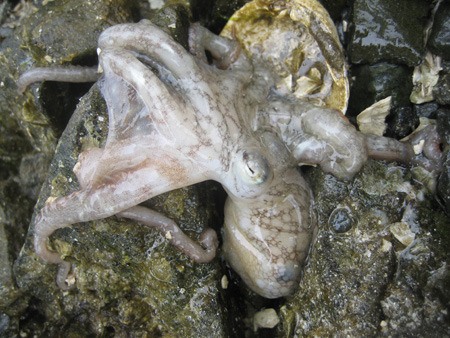How smart is an octopus? What do peanut worms eat? How fast can a starfish run? How do sea slugs breed?
Questions about the secret lives of marine invertebrates around Indian Island will be answered by local volunteers, Orcas High School students, and Kwiáht Ecologist Russel Barsh at the first annual Tides of March celebration at the Eastsound fire station, March 15, 4:30 to 6 p.m., preceding the last SeaDoc Society marine lecture of the season.
Since the Indian Island Marine Health Observatory was established in 2009, volunteers have documented nearly a hundred species of crabs, starfish, sea slugs, and other marine invertebrates that live their lives mostly unseen just a few hundred feet from Eastsound’s Main Street. Some of them are familiar, like the blue and orange ochre stars that can be found in pile-ups under boulders at low tide.
Others are surprising and strange — like the colonial ascidians or “sea quirts” that look just like blobs of raspberry jam, but are actually communities of tiny animals that are distant ancestors of vertebrates like fish and humans. A dozen species of lazy worms hide on the undersides of starfish and share their lunch.
Orange-and-white opalescent sea slugs hunt sea anemones, finding them underwater by smell, while the delicate gelatinous hooded sea slug runs down fleeing shrimp, flapping their entire bodies like a jellyfish. More than a dozen species of sea slugs can be seen at Indian Island.
Three species of octopus have been seen thus far around Indian Island: the red octopus, which can live hidden among rocks in the inter-tidal zone, as well as the giant pacific octopus, and the delicate gray smooth-skinned octopus, which is rarely seen even by divers.
Squid also frequent the island, laying their egg capsules on nearby sand flats. Visitors are welcome to watch researchers at work around Indian Island on low-tide days from April to August.
A schedule will be released at the March 15 event. In addition, up to four private tours of the island’s marine wildlife with Russel Barsh will be auctioned at the event.
For more info, visit www.kwiaht.org.



